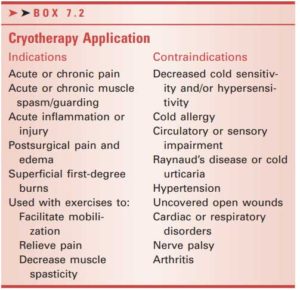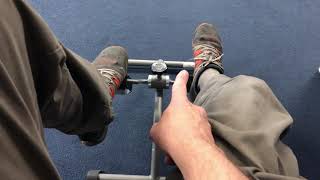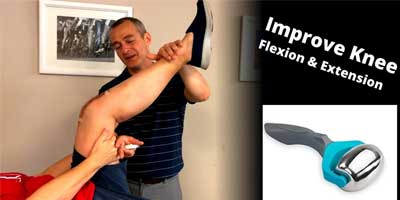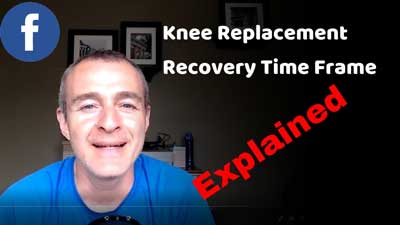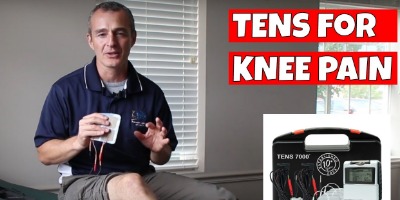How long should I ICE my knee after knee replacement?
Article Updated 06/08/2022
How long should I ice my knee after knee replacement surgery?
After a total knee replacement surgery many surgeons will often recommend icing the knee as often as possible.
In this article, I will review the current myths and misconceptions about using cryotherapy after knee replacement surgery and what is the number 1 reason to consider icing.
3 of the Most Common Myths Around Icing After Surgery:
- Icing reduces inflammation
- Icing reduces swelling
- Icing helps to heal injured tissue
3 Actual Truths Behind Icing After Surgery:
- Cold therapy will numb the superficial nerve endings which may reduce the experience of pain.
- Cold therapy provides a novel stimulus for the central nervous system and may interrupt the transmission of information being perceived as threatening.
- Cold therapy is inexpensive and easy to use at home. It is convenient and provides you with a sense of control which may help empower you to take control of your pain.
What does the research suggest?
A 2007 study determined that only an analgesic effect was demonstrated with continuous cooling. This study also determined that 4 degrees Celsius (39.2 degrees Fahrenheit) was determined to be comfortable for most patients. [1] A 2012 study analyzing the possible benefits of R.I.C.E. was inconclusive. [2]
How long should I place ice on my knee?
According to Therapeutic Modalities “Cryotherapy is usually applied for 20 to 30 minutes for maximum cooling of both superficial and deep tissues.” In many physical therapy clinics, the common recommendation is 10-minutes of sustained application. A couple of considerations to determine the length of time ice is placed on your post-surgical knee include
- How cold is the ice pack?
- Are you placing a piece of cloth or other covering between the ice and your skin?
- Are you applying ice to a part of the body with a thicker fatty tissue layer?
When should an ice pack be avoided?
The following table comes from Therapeutic Modalities section II page 168 –
Myth Buster #1 – Cryotherapy does not reduce inflammation.
Inflammation is a chemical process within the body and is largely regulated by the immune system. Placing an ice pack on the skin to change the skin’s temperature will not significantly impact the chemical response to tissue injury and repair known as inflammation.
Myth Buster #2 – Icing reduces swelling
Swelling and edema are also regulated by chemical changes at the site of injury. Changes in temperature applied to the skin can not significantly change the chemistry deep under the skin. If a noticeable change in swelling is noted upon removal of an ice pack it is largely due to the mechanical compression of the ice pack squeezing the fluid out of the area and not due to the cold temperature of the ice pack.
Myth Buster #3 – Icing improves healing.
Since the healing response is autoregulated by the body’s immune system, changes in superficial skin temperature have not been shown to significantly affect healing times. The best-known evidence of healing tissue following surgery includes a short episode of rest followed by an active recovery guided by a physical therapist, occupational therapist, or other qualified healthcare professional.
Summary:
Based on the available evidence, I would recommend using either cold therapy or heat therapy solely for an analgesic benefit. I would advise against taking time away from a more active recovery to sit with an ice pack or heating pad on your knee. If cold or warmth feels good and helps bring relief between bouts of activity these modalities are generally considered low risk for complications and inexpensive.
The bottom line is to do what feels good while you are resting, but stay active and keep moving when possible.
Facebook Group Comments
Another trick that helped me, was carrying an old fashion ice bag around and keeping ice on my knees all day even while going on excursions. Most restaurants and QT‘s gas station will let you fill up a cup and pour it into your ice bag. This bag CVS
Cited References:

Anthony Maritato, PT
Physical Therapist
Anthony Maritato, PT has been a licensed physical therapist and private practice owner since 2006. Ohio license #PT011602.
Anthony has been passionate about helping patients recover from total knee replacement surgery as well as rotator cuff repair surgery.
About the Author -
Anthony Maritato, PT has been a licensed physical therapist since 2006. He specializes in post surgical care and rehabilitation of total knee replacement and rotator cuff repair surgery.
Mr. Maritato is also nationally recognized as a therapist educator teaching courses related to Medicare reimbursement, contracting, and documentation.
Total Therapy Solutions LLC is Tony's primary practice which he owns with his wife Kathy who is also a licensed physical therapist.
More Blog Posts …
Best Orthopedic Doctor in Fairfield Ohio
Meet Dr. James Doug Abbott, MD an orthopedic surgeon who specializes in knee replacement surgery as well as other preventative knee care. In this interview Dr. Abbott, MD and Anthony Maritato, PT discuss trends in knee replacement surgery, jogging after knee...
5 Things to do While Recovering from Knee Replacement
Learning a new skill or hobby is a great way to pass the time while recovering from knee replacement surgery.
BEST Pedal Exerciser After Knee Replacement in 2021
A pedal exerciser is a perfect solution for anyone that has had total knee replacement surgery. This exercise bike is great because it is lightweight, inexpensive, and versatile. Below are videos and recommendations showing you how to use this mini-cycle for both...
Improve Range of Motion and Reduce Swelling After A Total Knee Replacement
To learn how to improve range of motion while reducing the swelling in your knee after a total knee replacement READ MORE>
Preparing for a Knee Replacement the EASY Way
Step 1 – Take a pre-operative knee replacement class. Step 2 – Schedule a pre-operative physical therapy evaluation. Step 3 – Create a battle plan for your recovery. Learn how to achieve each of these steps in this article.
Total Knee Replacement Recovery Time Frame
The first 48 hours after knee replacement surgery your top priority is pain management and rest. Days 3-10 focus on range of motion and walking. Next…
How Soon After Knee Replacement Can I Use A TENS Unit
TENS is a safe and effective pain control strategy used within the first 24-hours following knee replacement surgery. This post will review several studies discussing the use of TENS to reduce pain without opioid use.
7 Stretching & Strengthening Exercises for Frozen Shoulder
I review the 7 Stretches and Strengthening exercises for frozen shoulder (adhesive capsulitis) originally shared by Harvard Health Publishing
Is It Safe To Jump Rope After A Total Knee Replacement
Jump rope may be a great precursor to running activities after a total knee replacement. Jump rope allows
Total Knee Replacement Pre Surgery Online Class
If you are schedule for a total knee replacement surgery or you already had your surgery and would like to learn more, this FREE class may be the perfect option for you.
